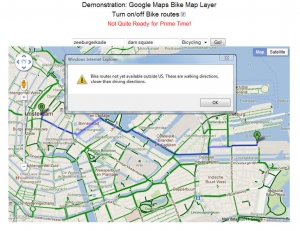Coming soon? Google bike mapping in Amsterdam
 Over a year ago, Google announced a bike path layer and biking routes in the U.S. It seems this is easier said than done in Europe. But they must be close! Playing with Google api V3 we discovered the Bicyclinglayer, and discovered it exists here too! Here is my sample map (8/1/2019 – doesn’t work any more). The bike layer can be turned on or of, but attempt to route for Biking and it does not work. (It would work in the US, except that I have switched to “walking” for this demo.)
Over a year ago, Google announced a bike path layer and biking routes in the U.S. It seems this is easier said than done in Europe. But they must be close! Playing with Google api V3 we discovered the Bicyclinglayer, and discovered it exists here too! Here is my sample map (8/1/2019 – doesn’t work any more). The bike layer can be turned on or of, but attempt to route for Biking and it does not work. (It would work in the US, except that I have switched to “walking” for this demo.)
 There is already the international open cycle map layer… so can’t they get together on this? Open cycle map is one of the backgrounds on the excellent free website, Bikemap.net. However this is a point and click route planner, and does not use the underlying bike map layer for routing.
There is already the international open cycle map layer… so can’t they get together on this? Open cycle map is one of the backgrounds on the excellent free website, Bikemap.net. However this is a point and click route planner, and does not use the underlying bike map layer for routing.
 Another approach, specially designed for use in Amsterdam is Routecraft Routeplanner, was developed by DAVdigital which also makes customized maps, interactive and static, for organizations in and around Amsterdam. This one really works (within greater Amsterdam), so it wins the prize for up-and-running.
Another approach, specially designed for use in Amsterdam is Routecraft Routeplanner, was developed by DAVdigital which also makes customized maps, interactive and static, for organizations in and around Amsterdam. This one really works (within greater Amsterdam), so it wins the prize for up-and-running.





